Table of Contents
- Fruit Trees
- Ornamental and Flowering Trees
- Palm Trees
- Mediterranean Trees
- Choosing Your Tree
- When Is the Best Time to Plant Trees?
- How to Plant a Tree
Introduction
Who wouldn’t want garden trees in their life? They are the backbone of any garden – large or small. Think you don’t have room for trees in your garden? Think again. Whether you're looking to create a peaceful retreat, a wildlife haven, or your own mini orchard, trees provide structure, beauty, bounty, and a host of environmental benefits. Are you sold yet? No? Hang on.
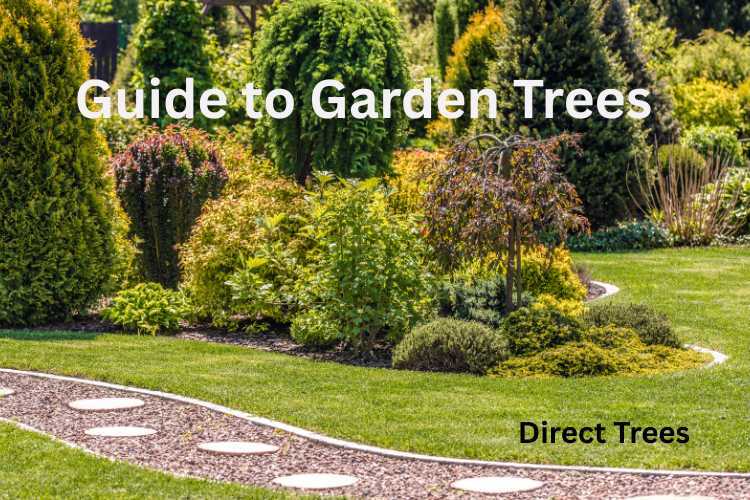
Garden trees also offer year-round interest, from spring blossoms and lush summer canopies to colourful autumn foliage and even wintry silhouettes. But even beyond their good looks, trees are great for the environment and provide homes for birds, insects, and other wildlife.
By planting garden trees, you’re not just improving your garden—you’re contributing to a healthier planet.Which has to make you feel good about yourself and the garden.
Popularity of Trees
As we all become more aware of the environment there has inevitably been a growing trend towards more sustainable, wildlife-friendly gardening. And trees, whether ornamental, fruit, or flowering are featuring more and more on gardeners shopping lists. More of us to plant trees that support wildlife, such as rowan, crab apple, and hawthorn, which provide in spring and berries for birds in autumn.
There has also been surge in interest in productive gardening, where homeowners are looking to grow their own food. Given the cost of living this shouldn’t be a surprise but it is also good for the environment and, not to be forgotten, growing your own fruit, whether it’s from a compact patio apple tree or a full-sized plum or pear tree, is great fun. Edible landscaping, including fruit trees in your garden design, is becoming a bit of a trend. Meanwhile, those looking to create exotic or Mediterranean-style gardens are drawn to hardy palms, olives, and citrus trees.
But No matter what style or size of garden you’re working with, choosing the right tree will add so much value for many years to come.
Different Types of Garden Trees
Trees come in many forms, from productive fruit trees to purely decorative ornamental varieties.
Fruit Trees
You’ve got to love fruit trees, especially if you’re a fan of homemade jams, pies, and desserts. And who isn’t?
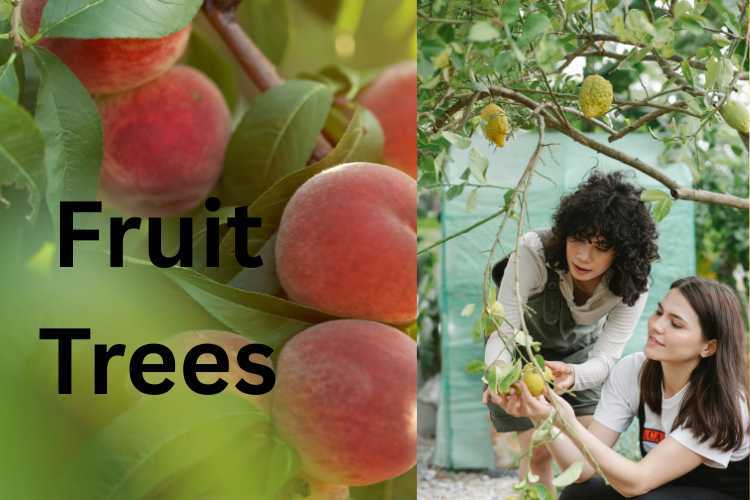
Self-Fertile vs. Pollination-Dependent Fruit Trees
Self-Fertile Trees: These trees can produce fruit on their own without requiring pollen from another tree. These fruit trees are great for novice gardeners but are also Ideal for small gardens or urban spaces where there is only room for a single garden tree.
- Examples: Self-fertile apple varieties (‘Braeburn’), plums (‘Victoria’), and cherries (‘Stella’).
Pollination-Dependent Trees: These trees need a pollination partner (another compatible fruit tree) for them to bear fruit.
- Examples: Many apple varieties (‘Cox’s Orange Pippin’), pears, and sweet cherries.
Types of Fruit Trees
- Dwarf & Patio Fruit Trees: Perfect for container growing or small gardens, reaching only 1.5-2m in height.
- Standard Fruit Trees: Grow to full height (4m+), producing larger harvests but requiring more space.
- Espalier & Cordon Trees: Trained to grow against walls or fences, ideal for maximising space in smaller gardens.
Popular Varieties
- Apples: ‘Egremont Russet’, ‘Braeburn’, ‘James Grieve’.
- Pears: ‘Conference’, ‘Williams Bon Chrétien’.
- Plums: ‘Victoria’, ‘Opal’.
- Cherries: ‘Stella’ (sweet), ‘Morello’ (sour).
- Figs: ‘Brown Turkey’ (hardy for UK climates).
- Citrus Trees: Lemons and limes, best suited to conservatories or pots with winter protection.
Ornamental and Flowering Trees
Ornamental garden trees provide year-round beauty with stunning flowers, foliage, and striking bark.
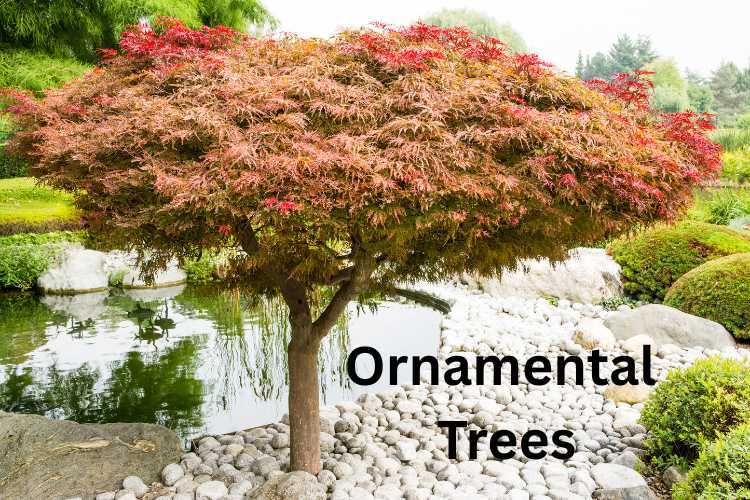
Popular Ornamental Trees
Ornamental garden trees (as their name suggests) provide year-round beauty with stunning flowers, foliage, and even the bark looks great. There are so many ornamental trees to choose but some of the most popular with our customers are:
- Japanese Maple: : I’m sure 99% of people reading this have planted an acer in their garden. They have delicate, deeply lobed leaves that turn fiery red and orange in autumn. Prefers sheltered spots with partial shade.
- Flowering Cherry: Another huge favourite a flowering cherry tree will give you spring blossoms in shades of pink and white, followed by attractive foliage. Varieties like 'Kanzan' are particularly popular.
- Magnolia: Has large, fragrant flowers in early spring before the leaves emerge. 'Magnolia stellata' is a compact variety suitable for smaller gardens.
- Hawthorn: A native tree with clusters of white or pink flowers in spring, followed by red berries in autumn. 'Paul's Scarlet' is a notable cultivar.
Palm Trees
It doesn’t seem right, does it? But palm trees can thrive in the Uk and they will add an exotic touch to any garden. Of course, you have to choose the correct variety but there are a surprisingly large number of palms which are fully UK hardy that you can grow in your garden.
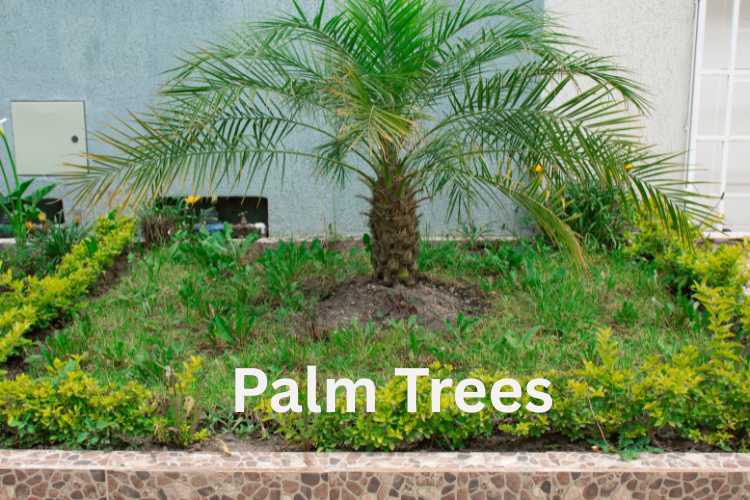
Some of the more popular choices include:
Popular Hardy Palms
- Trachycarpus fortunei: One of the hardiest palms which can survive even the hardest British weather. It has large, fan-shaped leaves and can grow up to 15ft tall.
- European Fan Palm: A fully hardy palm with dark green fan-shaped leaves, forming a woody trunk as it matures. As it will only reach five or six feet in height it can be grown in gardens or large pots.
- Canary Island Date Palm: While slightly less hardy, it can tolerate temperatures down to -5°C. This has the classic palm look with arching fronds. Best suited for sheltered spots.
Palm Tree Care Tips
If you haven’t grown a palm before here are few tips to help you get the best from your tree.
Location: Choose a sheltered spot with well-draining soil. Palms prefer full sun but can tolerate partial shade.
Protection: Wrap the trunk with horticultural fleece during severe frosts and mulch the base to protect the tree’s roots.
Watering: While established palms are drought-tolerant, don’t be afraid to water your tree regularly during prolonged dry spells to keep the tree healthy.
Mediterranean Trees
Another exotic addition to your garden. Mediterranean garden trees will bring a touch of southern Europe to your garden.
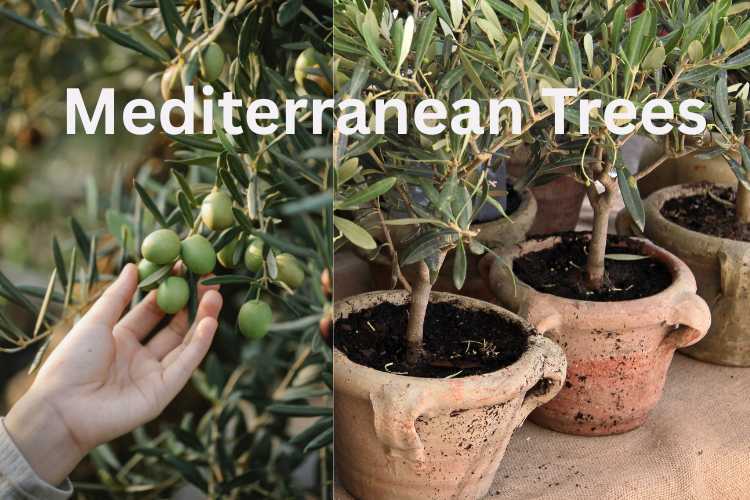
Popular Mediterranean Trees
- Olive Tree: What could possibly be more Mediterranean? Olive trees are elegant evergreens that bear tiny off-white flowers in summer, followed by edible green fruits..
- Italian Cypress: Tall and slender, these evergreens add vertical interest and are ideal for formal designs.
- Stone Pine: Has an umbrella-shaped canopy and edible pine nuts. It thrives in well-drained soils and sunny positions.
Care Tips
Soil: Mediterranean garden trees will need well-draining soil to prevent root rot. Adding grit to heavy soils can improve drainage.
Position: Full sun is essential for these sun-loving species to flourish.
Winter Protection: While many Mediterranean trees are hardy, young plants will benefit from protection during winter.
Choosing Your Tree
It’s always exciting to buy a new tree but which do you choose? It depends on the size of your garden, soil type, and how much sunlight the space receives. It also depends on how much time you want to spend on after-planting care. Some garden trees will need regular maintenance, while others are best left to grow naturally. Here’s a few things to consider when buying your next tree.
How Much Room Do You Have?
Not rocket science but you don’t want an overpowering large tree in a small garden and vice versa. Fortunately, there are trees for every garden size.
Small Gardens and Patios
If you have limited space, opt for compact or slow-growing trees. Dwarf fruit trees, Japanese maples, and flowering cherries are great choices. For patios and courtyards, container-friendly trees such as olives and bay trees can be pruned to keep them manageable.
Medium Gardens
A bit ambiguous, but in medium-sized gardens, you have more flexibility. You can go for just about anything. A crab apple tree is a popular choice as it provides spring flowers, edible fruit, and autumn foliage.
Large Trees for Bigger Spaces
If you have a large garden or a rural property, you can plant traditional British trees such as oak, beech, and sweet chestnut. If you want impressive size but faster growth, silver birch is a great option.
Soil and Drainage
Some trees tolerate poor soil, while others need well-draining soil to establish strong roots. Let’s look at trees suited to different soil types.
- Clay: Retains water but can become compacted. Trees like hawthorn, alder, and field maple can grow well in this soil.
- Loam: If you’re lucky enough to garden on loam you’re spoilt for choice. It’s the ideal soil for most trees, including fruit trees, Japanese maples, and rowan.
- Sandy: Drains quickly but can be low in nutrients. Mediterranean trees like olive, pine, and fig prefer well-drained conditions.
- Chalk: Alkaline soils can be tricky, but trees such as silver birch, yew, and crab apple adapt well.
Don’t worry if your soil isn’t ideal for garden trees, it can often be improved before planting. Adding organic matter like compost or well-rotted manure will improve drainage in heavy clay and improve moisture retention in sandy soils. A layer of mulch around the base of the tree will also help no matter which soil type you have in your garden.
Sunlight and Shade
You can grow trees in full sun or even in that shady corner that you rarely venture into.
Trees for Full Sun
If your garden gets sun for most of the day, choose trees such as olives, ornamental cherries, or silver birch. Fruit trees, especially apples and pears, also need full sun if you want them to crop heavily.
Trees for Partial Shade
Some our gardens don’t get much sun. That could be down to nearby buildings or other trees for example. But you can still go for varieties like hornbeam, rowan, or Japanese maples. They’ll all tolerate partial shade and will definitely brighten up that neglected corner of the garden.
How Trees Can Create Natural Shade
If your garden is too exposed, planting a tree can provide much-needed shade. Multi-stemmed trees will throw a light, dappled shade that allows other plants to grow beneath them, while larger species like horse chestnut will cast a deeper shade, perfect for seating areas.
Deciduous vs. Evergreen – Which is Best?
You can of course have both but you may want to consider the differences between the two when thinking about your planting scheme.
Deciduous Garden Trees: These lose their leaves in winter but still provide plenty of seasonal interest with foliage in spring, colours in autumn, and sometimes flowers or fruit. Examples: Japanese maple, silver birch, and ornamental cherries.
Evergreen Trees: As their name suggests they keep their foliage and colour all year round. They are great for screening and hedging. Examples: Holly, bay, and yew.
Combining Both: Why not choose a mix of deciduous and evergreen trees for variety? A row of evergreen trees for privacy, combined with deciduous trees for seasonal colour beauty, will give you the best of both worlds.
Fast-Growing vs. Slow-Growing Trees
When You Need Quick Impact:If you’re looking for fast-growing trees to provide shade, screening, or to just look great in a hurry you could do much worse than silver birch, willow), and alder. These trees grow quickly and will fill out the space within a few years.
Slow-Growing Trees with Long-Term Beauty: If you’ve got plenty of time and an eye for a long-term project, planting slower-growing trees like oak, beech, and magnolia will more than reward your patience.
Low-Maintenance vs. High-Maintenance Trees
If you prefer a slightly easier stint in the garden, you’ll probably favour trees which don’t take much looking after against those where you’re having to whip out the pruning shears every two weeks. But you do have a choice.
Low-Maintenance Trees: Silver birch, rowan, and flowering cherry require little pruning and thrive in a variety of conditions. Olive and bay trees also need little attention once established.
High-Maintenance Trees
Fruit trees need annual pruning for better yields, while fast-growing trees like willow may need frequent trimming to prevent overgrowth.
Best Trees for Different Gardens
Choosing the right tree depends on more than just soil type and sunlight—size is important too. A small courtyard needs a very different tree from a sprawling larger space. If you’re on an exposed coast your trees will need to tolerate strong winds and salty air. If you want to attract local wildlife the trees you pick need to be attractive to birds and pollinators. But it you’re thinking of a more exotic Mediterranean feel; your choices need to help you achieve a sun-drenched aesthetic.
Small Gardens and Courtyards
You don’t want to overpower the space but even in a courtyard or on a patio, the right tree can provide shade, seasonal interest, and structure.
- Amelanchier: A small, multi-stemmed tree with delicate white spring blossoms, followed by berries and fiery autumn foliage.
- Ornamental Cherry: A narrow, upright tree that produces stunning pink flowers in spring without taking up too much space.
- Fig: : Ideal for growing in pots, fig trees provide large, architectural leaves and delicious fruit in warm summers.
Large Gardens
If you’ve got a bigger space, you may as well fill it.
- Oak: A classic British tree, providing longevity, shade, and habitat for wildlife.
- Beech: A stately tree with dense foliage that turns golden in autumn.
- Sweet Chestnut: A tall tree with edible nuts, ideal for parkland settings.
Coastal or Windy Gardens
On the coast you’ll have to battle strong winds, sandy soil, and salt-laden air. Makes sense then that the best trees for these gardens are those that can withstand exposure.
- Sea Buckthorn: A hardy, spiky tree with bright orange berries, excellent for coastal windbreaks.
- Pine: Adaptable and resilient, providing height and wind resistance.
- Tamarisk: A graceful tree with feathery pink flowers, perfect for seaside gardens.
Wildlife-Friendly Gardens
We’re all friends of the environment and who doesn’t enjoy watching birds from out of the window?
- Crab Apple: Provides spring blossom for bees and autumn fruit for birds.
- Rowan: Berries attract thrushes and blackbirds, while flowers support pollinators.
- Silver Birch: Hosts a wide range of insects and provides seeds for finches
Mediterranean Gardens
While we can’t import the hot weather, we can still create a tropical look in our gardens.
- Olive: A hardy, evergreen tree that thrives in pots or well-drained soil.
- Palm: One of the few palms that can survive UK winters, adding an instant tropical feel.
- Citrus Trees (Lemon & Orange): Best grown in containers and moved indoors during winter.
To complete the look, pair Mediterranean trees with lavender, rosemary, thyme, and agapanthus, all of which thrive in dry conditions and provide fragrant, colourful underplanting.
When Is the Best Time to Plant Trees?
The best time to plant your trees depends on whether they are bare-rooted or not.
Bare-root trees (sold without soil around the roots) should always be planted in autumn or winter (November to March) while they are dormant. Planting at this time ensures the roots have settled before spring, allowing them to focus on growth rather than survival.
Container-grown trees (trees sold with soil in a pot) offer more flexibility and can be planted year-round, but they still do best when planted in autumn or early spring when conditions are cool and moist.
Autumn is often considered the ideal planting season because the soil is still warm from summer, giving roots a chance to grow before winter. Spring planting is usually best for fruit trees. But you can plant trees all year round just remember to water regularly if planting in the summer and avoid waterlogged or frozen ground if planting trees in winter.
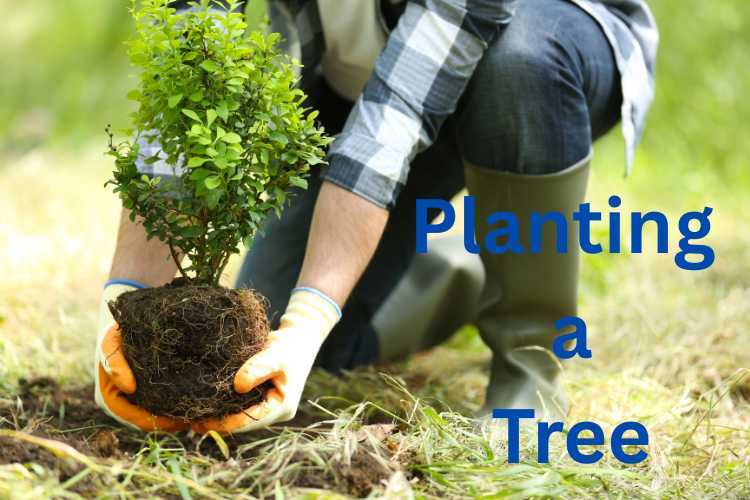
How to Plant a Tree
- Choosing the Right Location
- We’ve already discussed the importance of thinking about the space where your tree will grow. It needs enough room to spread its roots and branches without being too close to buildings, fences, or power lines.
- Think about the light. Some trees need full sun, while others thrive in partial shade.
- How exposed is the site? Young trees are vulnerable to strong winds and may need temporary shelter or staking.
- Preparing the Planting Hole
- Dig a hole that is twice as wide as the root ball but no deeper than the original soil level of the pot the tree was supplied in. This allows the roots to spread easily while ensuring the tree isn’t buried too deep, which can lead to rot.
- Loosen the soil at the base and sides of the hole to help roots penetrate the ground.
- If planting in heavy clay or sandy soil, mix in compost or well-rotted manure.
- Staking and Support
- Not all trees need staking, but those which are tall or top-heavy or planted in exposed areas should be staked.
- Use a sturdy wooden stake placed at a 45-degree angle to avoid damaging roots.
- Loosely bind the tree to the stake with a flexible tie to allow for slight movement.
- Remove the stake after 1–2 years once the tree is stable.
- Watering After Planting
- Water well immediately after planting to help settle the soil around the roots and remove air pockets.
- Continue to water regularly for the first two years, especially during dry spells. Young trees need consistent moisture to establish strong roots.
Growing Trees in Containers
If you don’t have a garden or just want some variety you can grow some trees in a container instead of the ground. This is a solution for patios, balconies, and compact gardens.
Best Trees for Container Growing
- Fruit trees (dwarf apples, pears, figs)
- Ornamental trees (Japanese maple, bay trees, olive trees)
- Evergreens (Portuguese laurel, small conifers)
When planting a tree in a container make sure you use a free-draining compost mix and that the pot has plenty of drainage holes. Add a layer of gravel or crocks. Once planted water your tree regularly, as container trees dry out more quickly than ground-planted ones. In summer, check soil moisture daily. Remember to repot your tree every one or two years depending on size and growth.
Next Steps
If you’re ready to transform your garden with the perfect tree, now is the time to start. Whether you're looking for an ornamental, a fruit tree, or an evergreen, there’s a tree that will fit your space. Planting a tree is a simple but powerful way to enhance your garden, contribute to sustainability, and enjoy the many rewards trees bring over time. Make today the day you plant something that will grow for years to come.
Get started by browsing our full selection of garden trees.

